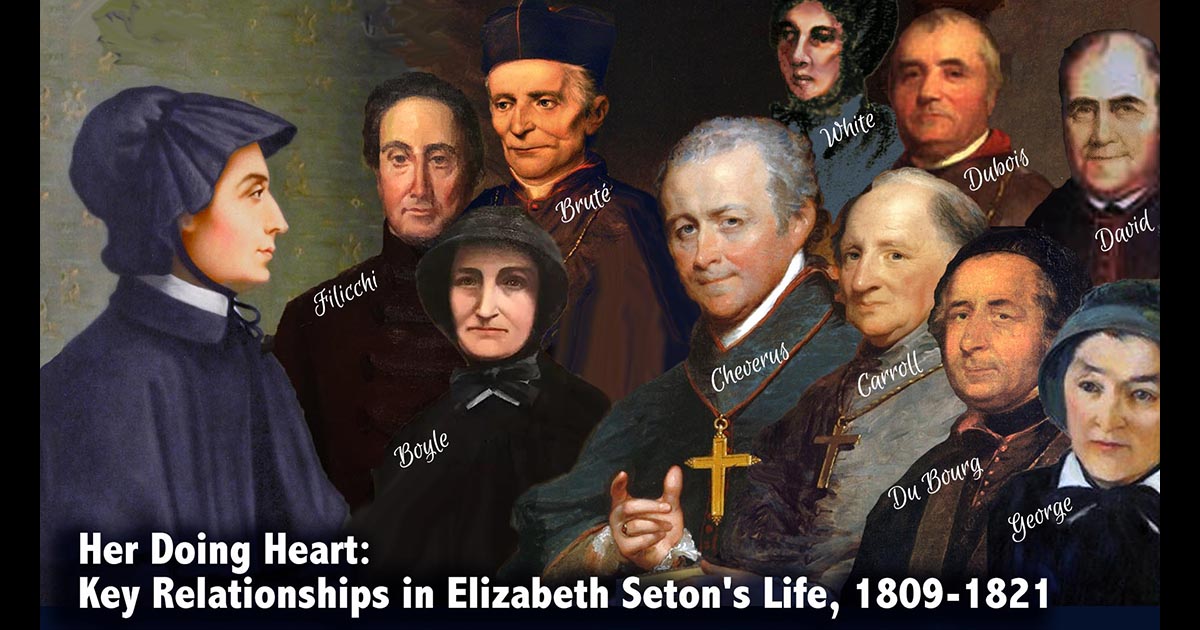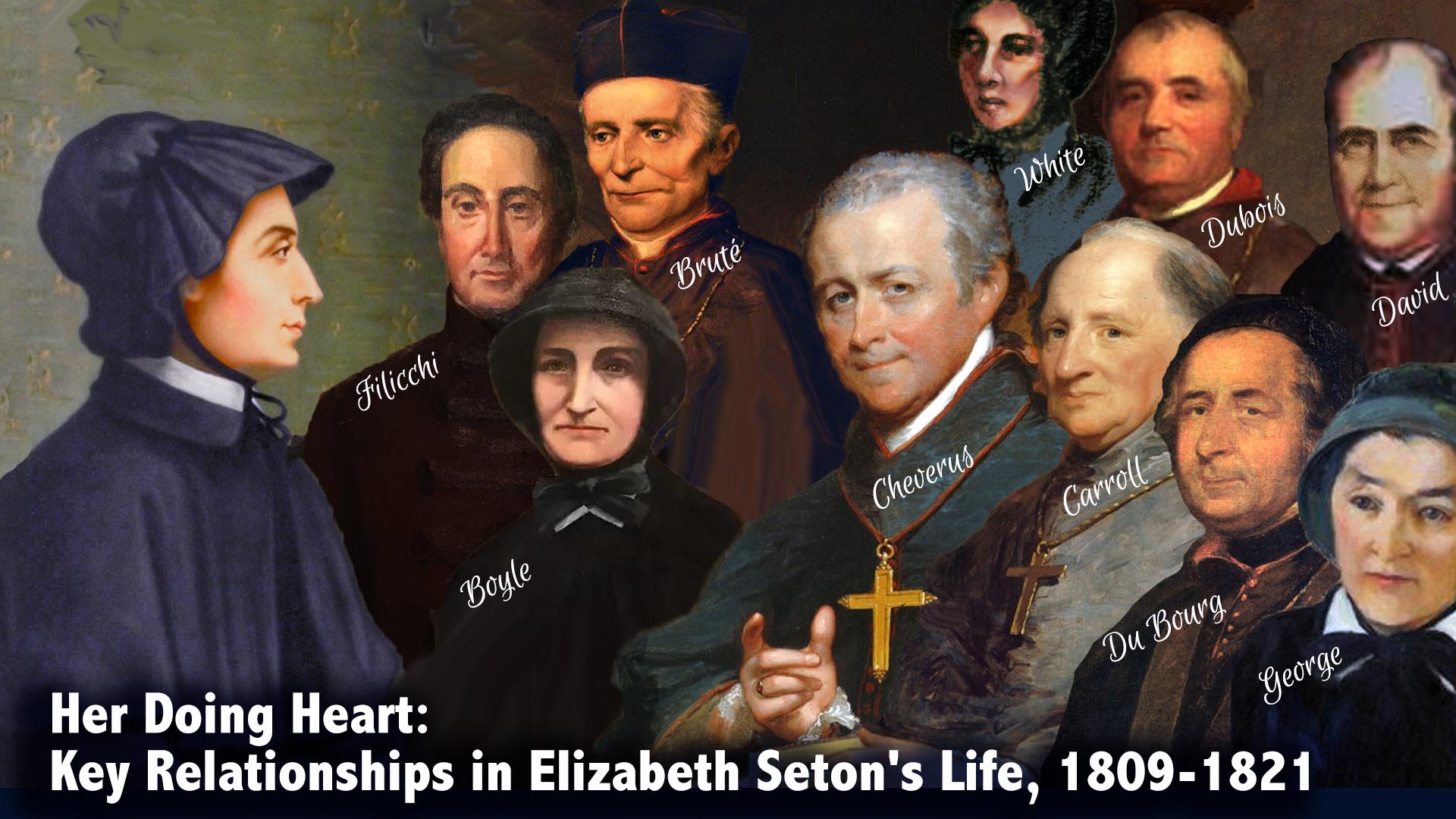Her Doing Heart: Key Relationships in Elizabeth Seton’s Life (Part 3)
Sr. Margaret John Kelly, DC, who died in Nov. 24, 2022, in Emmitsburg, wrote the following excellent article on Mother Seton (among her many other accomplishments). In this series we present her article in six parts.
PART 3
Her Doing Heart: Key Relationships in Elizabeth Seton’s Life
Elizabeth’s Relationship With John Carroll
Elizabeth’s correspondence with John Carroll (Bishop/Archbishop of Baltimore 1790-1815) provides many insights into the developing community and the growing Church as well as into the psyche of Elizabeth Seton. In her correspondence with Carroll, Elizabeth was extremely free, not only about the events within the community, but more importantly about her own mental states as a result of those developments. This is not surprising because a close bond had been formed when Bishop Carroll gave her a week of instruction and then confirmed her in New York in May 1806. A point of interest here is that Elizabeth took Mary for her confirmation name and wrote to Antonio Filicchi that Mary added to Elizabeth and Ann presents “the three most endearing ideas in the world.”[1] Elizabeth Ann Seton signed her letters to Carroll M. E. A. S. In regard to Elizabeth’s reliance on Bishop Carroll, it is helpful to remember that he also helped to educate her sons and did, in fact, become a major referral source for students, including his own relatives.
In the eighteen letters Elizabeth wrote to Carroll from 6 August 1809 to 9 October 1815, which have been reviewed for this paper, half of them are directly related to the government of the new community. There is a general unrest and, at times, even a bit of depression which surfaces as Elizabeth expresses her strong concern about the prohibition against Father Babade’s serving as confessor to the sisters, the varying styles of Dubois and Dubourg, the serious conflict with Rose White and the friction between herself and Father David. The delicacy of these relationships is captured as Elizabeth requested Carroll in August of 1809, “Promise that you will not speak of the contents of this or any other letter I may write to you, that without restraint I may speak to you as to our Lord.”[2]
In the Rose White-Elizabeth Ann situation, as in most difficult situations, the motivations are complex and the factors are many but it does appear that the problem arose when Rose White and Kitty Mullen wanted to maintain loyalties to Father David, while the other sisters were devoted to Father Babade. “Sister Rose and Kitty Mullen are the only persons in the community who have an interest in any other director and all the rest are of one heart and voice with respect to Father Babade it seems.”[3]
These differences appear in the Seton-Carroll correspondence from 1809 through 1811. The letters reveal a great deal about the importance of Carroll to the resolution but also of the tenor of life within the infant community. It is helpful to remember that because Carroll had instructed and confirmed Elizabeth Ann, he was close to her, but he had also officiated at the wedding of Rose Landry and Captain White in Baltimore when Rose was just fourteen.
At the end of the above referenced letter, Mother Seton writes, “Our dear Rose is my treasure-she is truly excellent-Kitty too is all goodness.” One is hard pressed to know if that praise comes from guilt for the early part of the letter or the ability of Mother Seton to separate personal animosity from the objective evaluation of a person’s contribution to the work. Just a month later on this issue of Father Babade, Elizabeth wrote revealing that the divisions continued, and speaks of “my girls.” “How many times have I begged our Lord to direct me what to do-on one hand I know it may displease you if I say any more on the subject, and on the other side my dear girls are continually begging me ‘Oh, dear Mother, do write to the Bishop, he is a Father to us and will not deny your request,’ but I have put them off … for my part I assure you that if it is not granted to me, you will leave a soul so dear to you in a cloud of uneasiness which can be dissipated in no other way.”[4]
It may be an unwarranted judgment but the manner in which Elizabeth referred to Rose and Kitty together suggests that Elizabeth may have perceived them as the other camp. In a December letter, she noted, “your favorite Rose and Kitty,” are very well.[5] Awareness of the potential for division appeared in the first council meeting (12 August 1809), when after the election the sisters took among their resolutions the following: “Resolved, to unite in repressing the too natural propensity to form private parties; and to watch over the natural good.”[6]
Again, a letter of 19 January 1810 ended with a brief report of the condition of Cecilia and Anna and with “Rose and Kitty are very well, except for colds.” On 5 December Elizabeth made a cryptic statement to the bishop: “It will grieve you to hear of our Rose’s indisposition of which both herself and I have written the Superior hoping some remedy may be applied in time.”[7] A letter of 16 March 1811 is very explicit and focuses on Rose.
Poor Rose had been a great sufferer of late and more from the mind than body-her anxiety to get to Baltimore has been a source of perpetual agitation, and Rev. Superior repeated letters for her corning at every risk (even of a waggon, if she could find a Christian waggoner) had determined Mr. Dubois to send her on horseback, but we find a better opportunity offers-I ventured to reason with her, and she replied she would go and from that time, there has been some reserve between us..
Rose’s virtues are truly valued by me and by us all, but from the time she knew she was proposed as Mother of this house in my place and that everyone in it should prepare themselves for the change (which I was directed myself to inform them by special letter immediately after my return from Baltimore) her conduct has undergone an entire change and has been very unfavorable to her happiness and ours….
You surely will not communicate this little letter to the Superior or Rose, as you value peace above all-blessings-my conduct to her is, as I wish it ever to be, founded on that love for him who loved us both so much; to this moment I have always shown her more attention and affection than anyone in the house and our reserve is of the mind not of the heart, her affectionate kindness to my children binds me by gratitude independent of our spiritual connection.[8]
There is no question that the difficulty of this relationship was brought to the Lord frequently, and Elizabeth confided in the Bishop in a way that is both therapeutic and self-assuring for her. However, the same intensity of feeling appears in a letter to the archbishop written two months later:
Yet do not imagine, my dear Father, that I accuse Rose of insincerity, but it is very certain that she had blinded herself on this subject-anyone in this house and Mr. Dubois, himself, though in so delicate a situation with respect to her, would candidly tell you that from the period of her being informed that she was to take my place, her behavior to the whole community took such a turn as to impress everyone with the idea that if she did not assume the whole authority of Mother, she fully expected to assume it, and often has so disheartened us all that after her departure, it seemed as if our spirits were all set at liberty. I tell you this from the same motive I have written the above, and even by the request of Mr. Dubois who has witnessed much more than I can ever tell you, but she has much to excuse her.[9]
It is a tribute to the deep spirituality and sense of mission which inspired both women that subsequent to all this, Elizabeth and Rose worked very closely together to establish the works of the emerging community.
—–
[1] Kelly, Numerous Choirs, 102.
[2] Elizabeth Seton to Archbishop Carroll, 6 August 1809, BAA.
[3] Ibid.
[4] Elizabeth Seton to Archbishop Carroll, 8 September 1809, ibid. Emphasis in original.
[5] Elizabeth Seton to Archbishop Carroll, 14 December 1809, ibid.
[6] [Anonymous] Mother Rose White (Emmitsburg: Maryland, 1936).
[7] Elizabeth Seton to Archbishop Carroll, 5 December 1810. BAA.
[8] Elizabeth Seton to Archbishop Carroll, 16 March 1811, ibid. Emphasis in original.
[9] Elizabeth Seton to Archbishop Carroll, 13 May 1811, ibid.
Source: Kelly, Margaret J. D.C. (1993) “Her Doing Heart: Key Relationships in Elizabeth Seton’s Life: 1809–1821,” Vincentian Heritage Journal: Vol. 14: Iss. 2, Article 7.








0 Comments